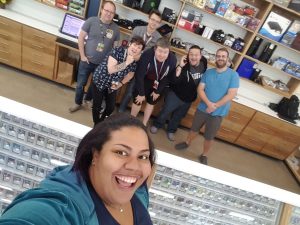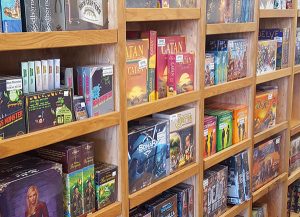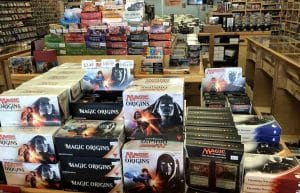When I asked Kay–the board game specialist at Level Up Games Mpls–to share her highlight of the board gaming business, she had this to say, “The best part about this job is the fact that we sell happiness. Everyone who comes through our doors leaves with a smile. Nothing is quite as rewarding as watching someone light up when they find something they weren’t expecting to find; or even when they find exactly what they were looking for.”
So what about the big shifts in board game business has Kay smiling? Well, let’s get this out of the way: the overall trend in the board gaming business is gravy. Specifically, industry data site ICv2 predicts that sales were up in the hobby channel (FLGS-friendly local game shops) by 5%. This would mark year-over-year growth for over a decade. In short, us nerds are buying more and more board games, which is great news.

But within this growth has come a lot of shifts within the industry. First, game mechanics are shifting. Modern games are not the same games as yesteryear. Data nerd Dinesh Vatvani has done a bang up job of data collection, creating a super handy dataset of well over 5,000 board games.
The old “spin and move” mechanics have been tossed aside, being seen as too random for modern strategy-loving gamers. On the rise are board games that utilize “hand management”, “co-operative play”, “modular board”, “dice pools”, or “card drafting” mechanics, among others.
Game themes are shifting as well. The historical themes of the heyday of war gaming have diminished. What has replaced them? Economic themes. Trading in the Mediterranean has never been more trendy.
Science fiction, fantasy, and general adventure themes have remained popular, and grown even. As have zombie and horror-themed gaming. “Trivia” theme games remain relatively popular, although they have seen a precipitous fall from their 80s and 90s heyday.
Too many games are being published. I’ve written extensively about this potential board game bubble before, so I’ll link you there. I will point out however that a deep thinking gentleman on Reddit called me names and insulted my intelligence regarding that article, disputing my reporting of 10 new board games being produced every day.
His defense was that 10 new board games a day on average felt wrong to him and that my claim wasn’t supported, despite the fact that I had five sources linked in the article. In sharing this I can both report that the insane number of board games produced is indeed a bubble that will someday inevitably pop, while also childishly pointing out the fact that I was 100% correct, which I never pass up an opportunity to do.

Kay said that so many board games creates a dilemma for a FLGS, mainly in terms of which ones to stock on the shelves. “The biggest challenge is predicting demand. You never know until something is completely sold out how the gaming community is going to respond. Some games get hyped for months and then come the release date, we might sell half of what was ordered. Other times it’s just the artwork or maybe even the theme that brings people out in droves. It’s a bit of a gamble, but we’re getting better at placing bets.”
Spending patterns are shifting as well. Retailers reported a decline in Magic the Gathering sales for the back half of 2017, and ICv2 backed up this claim with sales data. Many small game shops popped up primarily to sell Magic and haven’t done a good job diversifying their business beyond it, relying almost solely on collectible card games. Those kind of shops are in tough shape. A smarter FLGS–ones that diversified their business–are able to handle a decline in one area, particularly when RPG and board games sales are soaring.
The impact of online sales and counterfeiting is real. With online sales only accounting for 10-11% of total retail, the wailing and gnashing of teeth about how Amazon is putting mom and pop out of business is a little overblown. Still, a 10-11% sales drop is serious business for a business like a FLGS that is surely operating on a thin profit margin.
It’s also well known that many customers will drive to a shop and browse the shelves. But when they find something they like, they’ll pull out their phone and order it online at a steep discount and have it shipped to their door two days later.
What is complicating the matter even further is the amount of counterfeit games that are popping up. With so many board games being manufactured in China, its been too tempting for these manufacturing plants not to pilfer the tooling schematics so they can run a supply to sell for themselves.

A FLGS can’t compete with a discount that steep and still hope to pay their electric bill. But the good news is that counterfeiting is being recognized for the problem that it is and in a stroke of irony, popular online board game retailer coolstuffinc.com has taken measures to protect against counterfeits and others will hopefully follow.
But the biggest protection is community, something no counterfeiter or online community can replicate. I’ve written before about third place theory and Kay backs that up. She says that a good game shop is even more “just a hang out spot; [it’s] a community.”
The biggest shift to the board game industry has been Kickstarter, which has done nothing short of revolutionize it. But even Kickstarter is changing as well, again, something I’ve written fully about and will point you to.
Kay is working to weather those shifts, saying about the changes with Kickstarter, “It seems our customers are becoming more cautious Kickstarter backers, opting to wait to see if certain titles make it to retail, and frequently inquiring if we’re backing certain projects.”
One final trend that should all make us happy. Dinesh’s data shows that the average rating for a board game is rising. The most charitable way to interpret that data is not that nerds are being more generous in their reviews (because we know that ain’t happening) and to simply acknowledge that it must mean that through more detailed production insight, better manufacturing techniques, and increased skill in design, board games are getting better and better.
That should put a smile on every nerd’s face.

